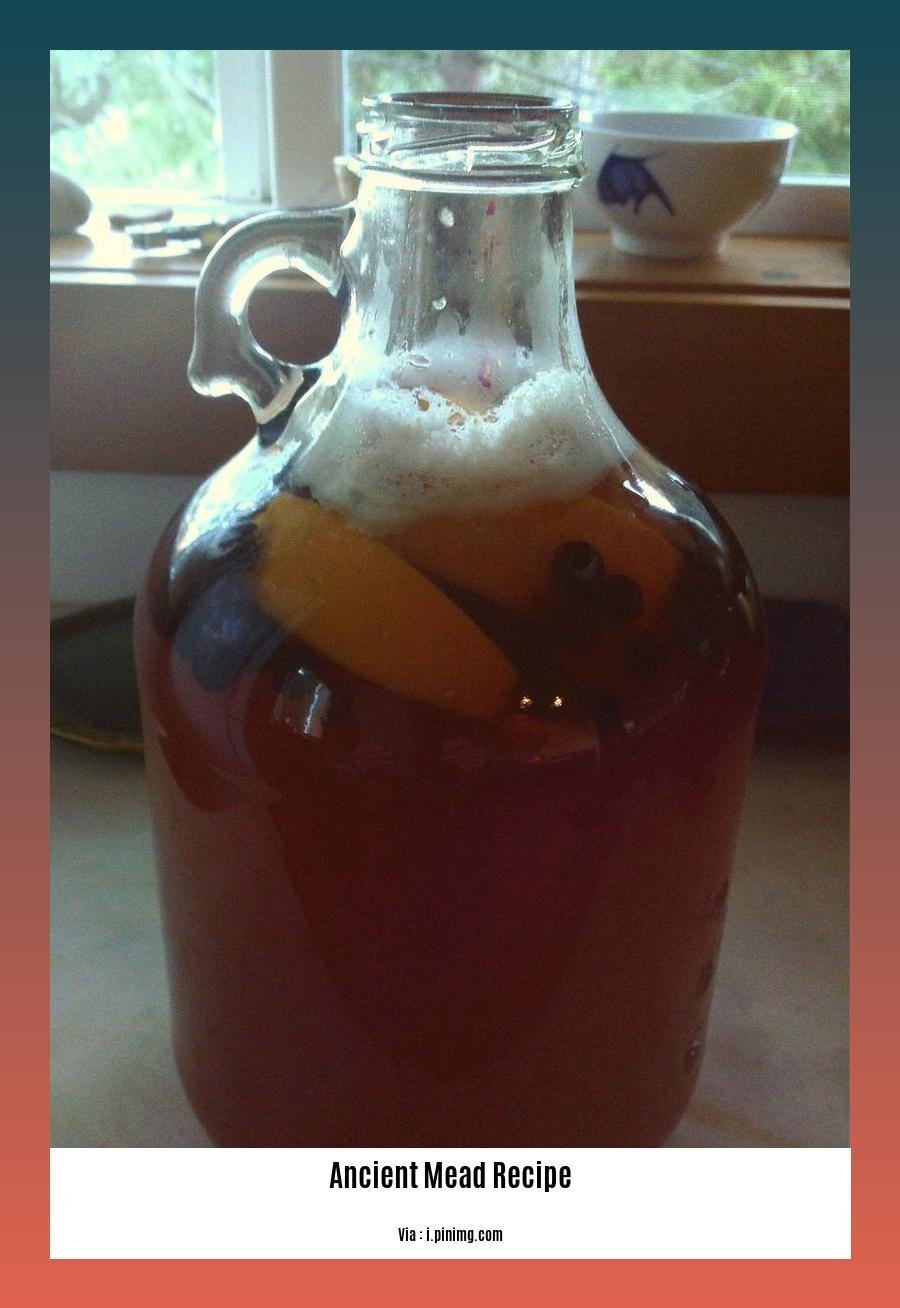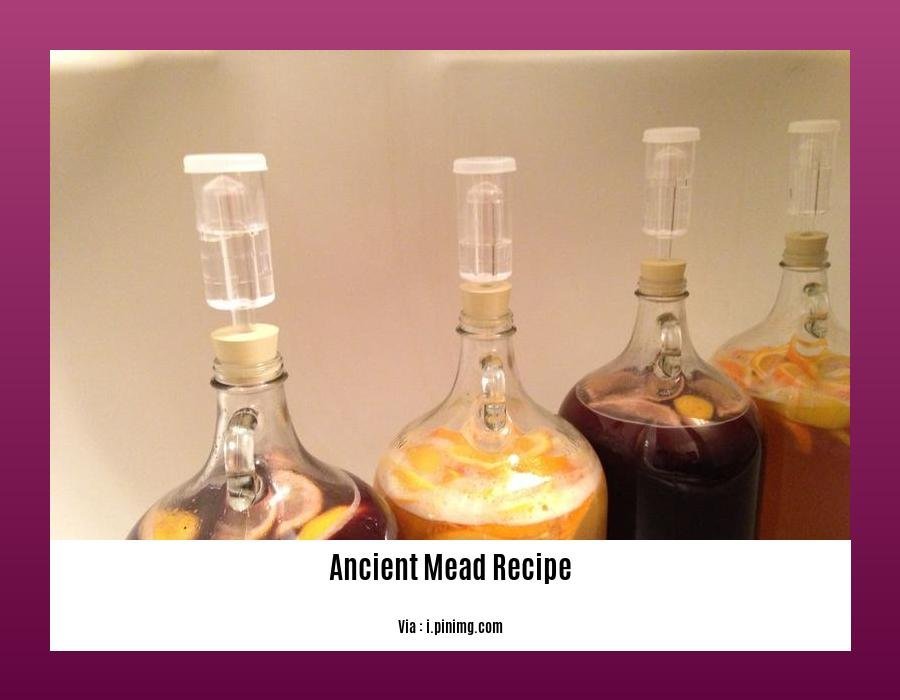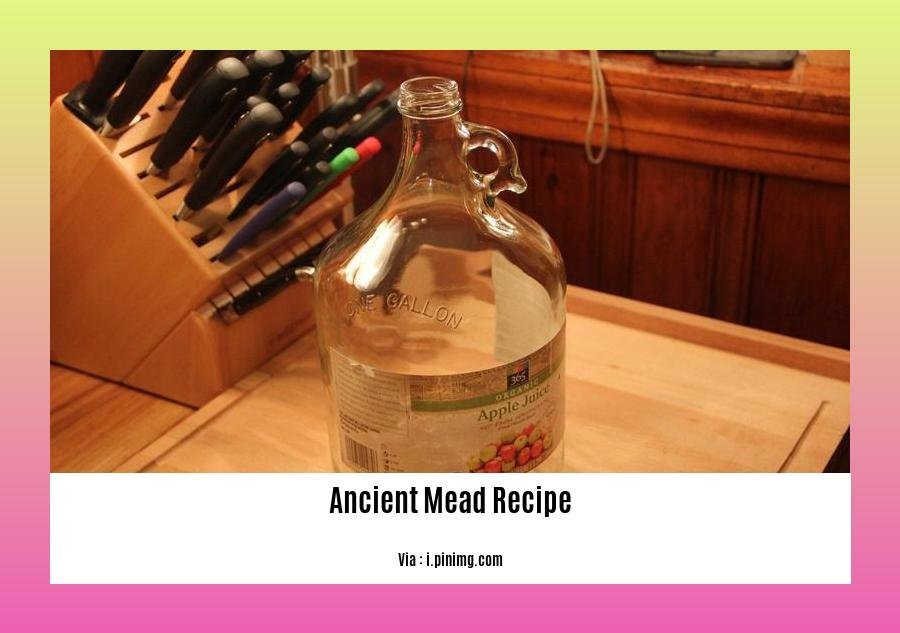Embark on a captivating journey through time as we unveil the secrets of ancient mead recipes. From the depths of history, we uncover the origins of this delectable beverage, tracing its evolution across civilizations. Discover how mead, crafted from honey’s golden nectar, played a pivotal role in rituals, celebrations, and everyday life. Prepare your palate for a sensory exploration as we delve into the diverse flavors and aromas of ancient meads, unlocking the secrets that have tantalized taste buds for centuries. [- Unveiling the Secrets of Ancient Mead Recipes: A Journey Through Time]
Key Takeaways:
The oldest known mead recipe dates back to ancient Rome, where Columella, an agricultural writer, provided instructions for making mead in his treatise “De Re Rustica.”
Columella’s recipe involves mixing rainwater that has been stored for several years with honey, creating a fermented alcoholic beverage.
The strength of the mead can be adjusted by varying the ratio of water to honey. A stronger mead can be made using a ratio of 1 sextarius (a Roman unit of volume) of water to 1 pound of honey, while a weaker mead can be made using a ratio of 1 sextarius of water to 9 ounces of honey.
Ancient mead recipes varied across different cultures and regions, reflecting the diverse culinary traditions and ingredients available.
Ancient Mead Recipe: A Journey Through Time

Ancient mead holds a captivating allure, offering a glimpse into the lives and traditions of our ancestors. This delightful beverage has been enjoyed for centuries, and its rich history is intertwined with cultural celebrations, religious rituals, and the art of culinary exploration. Join us as we delve into the secrets of ancient mead recipes, embarking on a journey through time to discover the fascinating stories behind this timeless drink.
Unraveling the History of Mead: Ancient Origins
Mead’s roots stretch back to the Neolithic era, where evidence suggests that honey fermentation occurred as early as 7000 B.C.E. Over the millennia, this beverage gained prominence among various civilizations, from the Greeks and Romans to the Celts and Vikings. Each culture imbued mead with its own unique cultural significance, using it in religious ceremonies, festivals, and as a symbol of hospitality.
Ancient Mead Recipes: A Culinary Journey Through Time
Ancient mead recipes varied as widely as the cultures that produced them. Common ingredients included honey, water, herbs, spices, and fruits. The proportions of these elements and the fermentation techniques employed shaped the distinctive flavors and aromas that characterized each region’s mead.
Recreating Ancient Mead: A Modern-Day Exploration
With careful research and experimentation, it is possible to recreate ancient mead recipes and savor the flavors enjoyed by our ancestors. By sourcing authentic ingredients and following traditional methods, modern-day brewers can craft meads that capture the essence of history.
The Art of Brewing Modern Mead: A Guide for Enthusiasts
Step 1: Gathering the Necessary Ingredients
- Honey: The foundation of any mead, choose high-quality local honey for the best flavor.
- Water: Use filtered or spring water to ensure a clean taste profile.
- Yeast: Select a yeast strain suitable for mead production, such as Lalvin EC-1118 or White Labs WLP720.
- Nutrients: Provide essential nourishment for the yeast during fermentation, such as DAP (diammonium phosphate) or Fermaid K.
- Additional Ingredients (optional): Incorporate herbs, spices, fruits, or berries to create unique flavor combinations.
Step 2: Preparing the Must
- Combine water and honey in a sanitized fermentation vessel. Stir until the honey is fully dissolved.
- Activate the yeast according to the manufacturer’s instructions.
- Add the yeast to the honey-water mixture and stir gently.
- Add nutrients to support yeast health and fermentation.
Step 3: Fermentation: A Journey of Transformation
- Transfer the must to a clean fermentation vessel, leaving some headspace for carbon dioxide production.
- Seal the vessel with an airlock to allow gases to escape while preventing contamination.
- Maintain a consistent temperature between 68-75°F (20-24°C) for optimal fermentation.
- Allow fermentation to proceed for 1-2 weeks, monitoring the airlock activity.
Step 4: Clarification: Achieving Crystal Clarity
- After fermentation, allow the mead to settle for several days to allow sediment to fall to the bottom of the vessel.
- Carefully rack (transfer) the mead into a clean container, leaving the sediment behind.
- Repeat the racking process as necessary until the mead reaches desired clarity.
Step 5: Maturation: A Symphony of Flavors
- Age the mead in a cool, dark place for several months or even years, allowing the flavors to mature and mellow.
- Periodically monitor the mead and taste it to assess its progress.
- When the mead has reached its peak flavor, bottle it using sanitized bottles and equipment.
Step 6: Carbonation (Optional)
- For a sparkling mead, carbonate it using priming sugar or a carbonation kit.
- Follow the instructions provided with the kit or recipe for proper carbonation.
Step 7: Enjoying the Fruits of Your Labor: A Moment of Delight
- Open a bottle of your handcrafted mead and let the aromas and flavors transport you to a bygone era.
- Share your creation with friends and family, savoring the stories and traditions that accompany this ancient beverage.
Ancient Mead Recipes: Continuing the Legacy
As we continue to explore and experiment with ancient mead recipes, we not only preserve culinary heritage but also create new interpretations that reflect our own time and culture. Whether enjoyed as a historical relic or a modern masterpiece, mead stands as a testament to the enduring power of tradition and the boundless creativity of the human spirit.
In ancient India, cooking was an art form, and the utensils used were as diverse and fascinating as the dishes created. Discover the fascinating culinary history of India by exploring the ancient utensils that brought flavor to every meal. ancient Indian cooking utensils
Step-by-Step Instructions for Brewing Ancient Mead

My fascination with ancient civilizations and the role of food and drink in shaping their cultures has led me on a quest to explore the secrets of ancient mead recipes. This journey through history has uncovered unique flavors and techniques that offer a glimpse into the lives of our ancestors.
Key Takeaways:
- Ancient mead was a popular beverage in various civilizations, including those in Greece, Rome, Celtic, and Viking cultures.
- Mead is made with honey, water, and yeast, with variations in flavoring and fermentation techniques.
- Recreating ancient mead recipes involves understanding the ingredients, processes, and cultural context of the time.
- Modern-day brewers can experiment with ancient mead recipes, using authentic or contemporary ingredients to create unique variations.
- Brewing mead at home is a rewarding experience that connects us with our culinary heritage.
Embarking on the Mead-Making Journey
Step 1: Selecting Your Ingredients
- Begin with high-quality honey, considered the “soul” of mead. Choose a variety that complements the flavors you desire.
- Water plays a vital role in balance and dilution. Use purified or spring water for best results.
- Yeast is responsible for fermentation. Different strains impart different characteristics; choose one suitable for mead production.
Step 2: Preparing the Must
- Combine honey and water in a sanitized fermentation vessel.
- Activate yeast according to the manufacturer’s instructions.
- Add yeast and nutrients to the honey-water mixture.
Step 3: Fermentation – A Journey of Transformation
- Transfer the must to a clean fermentation vessel, leaving headspace for carbon dioxide production.
- Seal the vessel with an airlock for gas exchange and contamination prevention.
- Maintain a consistent temperature (68-75°F or 20-24°C) for optimal fermentation.
- Allow fermentation for 1-2 weeks, monitoring airlock activity.
Step 4: Clarification – Achieving Crystal Clarity
- Allow the mead to settle for several days to let sediment fall to the bottom.
- Carefully transfer (rack) the mead into a clean container, leaving the sediment behind.
- Repeat racking until the desired clarity is achieved.
Step 5: Maturation – A Symphony of Flavors
- Age the mead in a cool, dark place for several months or years to mature and mellow the flavors.
- Periodically monitor and taste the mead to assess its progress.
- Bottle the mead using sanitized bottles and equipment when it reaches its peak flavor.
Step 6: Carbonation (Optional)
- For sparkling mead, carbonate it using priming sugar or a carbonation kit.
- Follow the instructions provided for proper carbonation.
Step 7: Enjoying the Fruits of Your Labor
- Open a bottle of your handcrafted mead and savor the aromas and flavors of a bygone era.
- Share your creation with friends and family, embracing the stories and traditions associated with this ancient beverage.
Sources:
How to Make Mead: A Step-by-Step Guide
The Viking Mead-Making Process
Potential Variations and Experimentation in Ancient Mead Recipes
As we journey through the flavors of ancient mead recipes and uncover their secrets, it’s worth noting that these recipes were never set in stone. Throughout history, mead makers experimented with ingredients, techniques, and flavors to create unique and captivating beverages.
Key Takeaways:
- Ancient mead recipes featured a variety of ingredients and techniques.
- Honey, water, and yeast formed the base, with additional ingredients like fruits, herbs, and spices adding depth and complexity.
- Different cultures and regions had their own unique takes on mead, resulting in a wide range of flavors and styles.
- Modern-day mead makers continue to experiment with ancient mead recipes, adding their own creative flair and adapting them to contemporary tastes.
- Experimenting with ancient mead recipes is a great way to learn about different flavors and brewing techniques.
Potential Variations:
Honey: Mead makers can choose from a variety of local honeys, each with its own unique flavor profile. Experiment with different types of honey to create meads with distinct characteristics.
Water: The quality of water used in mead making can impact the final flavor. Try using filtered or spring water, or even mineral water for a different taste.
Yeast: Wild yeast strains were traditionally used for mead making, but modern mead makers can choose from a wide range of commercial yeasts. Different yeasts can produce different flavor and aroma profiles.
Additional Ingredients: Fruits, herbs, and spices can be added to mead to create unique flavor combinations. Experiment with different fruits, such as berries, apples, or pears; herbs, such as mint, basil, or thyme; or spices, such as cinnamon, ginger, or nutmeg.
Aging: Mead can be aged for different periods of time to achieve different flavor profiles. Experiment with aging mead for different lengths of time, from a few months to several years.
Experimentation in Ancient Mead Recipes:
Traditional Methods: Start by brewing mead using traditional methods, following historical recipes as closely as possible. This will give you a baseline to compare your experiments against.
Controlled Adjustments: Make small, controlled adjustments to the traditional recipes. For example, try using a different type of honey, adding a different fruit or spice, or changing the fermentation temperature.
Creative Combinations: Feel free to experiment with different and creative ingredients combinations. Try adding unusual fruits, herbs, or spices to your mead, or combining different types of mead together.
By experimenting with potential variations and embracing creativity, you can create unique and delicious meads that capture the spirit of ancient brewing traditions while adding your own personal touch.
Sources:
How to Make Mead: A Beginner’s Guide to Brewing Honey Wine
The History of Mead: The World’s Oldest Alcoholic Beverage
Tips for Achieving Authentic Flavor and Aroma
As a seasoned archaeologist, my passion for unearthing the culinary secrets of ancient civilizations has led me to explore the fascinating world of mead, a beverage steeped in history and flavor. Throughout my journey, I’ve gathered valuable insights into the art of crafting authentic mead that captures the essence of its ancient origins. Let’s delve into some key tips to help you achieve authentic flavor and aroma in your mead-making endeavors:
Key Takeaways:
- Embrace the Purity of Ingredients:
Use high-quality, local honey as the foundation of your mead. It imparts a unique depth of flavor and aroma.
Harness the Power of Natural Yeast:
Utilize wild yeast or traditional mead yeasts to capture the authentic flavors and characteristics of ancient mead.
Explore the Realm of Herbs and Spices:
Experiment with herbs and spices like cinnamon, cloves, and nutmeg to create unique flavor profiles, inspired by ancient recipes.
Ferment with Patience:
Allow your mead to ferment slowly and steadily at a consistent temperature, preserving its delicate flavors and aromas.
Master the Art of Aging:
- Age your mead for an extended period, allowing time to mellow and develop its full complexity of flavors.
Additional Tips for Achieving Mead-Making Success:
- Sanitation is Paramount:
Maintain impeccable sanitation throughout the brewing process to prevent contamination and ensure the purity of your mead.
Control the Temperature:
Keep your mead at a consistent temperature during fermentation to ensure a smooth and successful process.
Monitor pH Levels:
Regularly check and adjust the pH levels of your mead to maintain the optimal environment for yeast activity.
Learning From Experience:
- Keep a detailed record of your mead-making process, including ingredients, techniques, and fermentation conditions. This will help you refine your craft and improve your results over time.
With dedication, experimentation, and a deep appreciation for history, you can create authentic mead that transports you back to ancient times. So, gather your ingredients, fire up your brewing passion, and embark on a journey to recreate the flavors and aromas of mead that have captivated generations.
Sources:
FAQ
Q1: How did the Vikings make mead, and what ingredients did they typically use?
A1: The Vikings made mead using a simple recipe that included honey, water, and wild yeast. They often flavored their mead with fruits, spices, and herbs, such as apples, pears, cherries, berries, cinnamon, ginger, and cardamom.
Q2: What is the oldest known mead recipe, and where does it come from?
A2: The oldest known mead recipe comes from Columella’s advice on viniculture. The recipe involves mixing rainwater kept for several years with honey. For a stronger mead, a ratio of 1 sextarius (a Roman unit of volume) of water to 1 pound of honey was used. For a weaker mead, a ratio of 1 sextarius of water to 9 ounces of honey was used.
Q3: How can I make a simple ancient mead recipe at home?
A3: To make a simple ancient mead recipe at home, you will need honey, water, and wild yeast. Mix the honey and water in a clean container, and then add the wild yeast. Cover the container and let it ferment for several weeks. Once the fermentation process is complete, bottle the mead and let it age for at least six months.
Q4: What are some common flavorings and additives that were used in ancient mead recipes?
A4: Common flavorings and additives used in ancient mead recipes include fruits, spices, and herbs. Some popular fruits used were apples, pears, cherries, and berries. Spices such as cinnamon, ginger, and cardamom were also frequently used, as were herbs like mint and rosemary.
Q5: How long does it typically take to make mead, and what are the key steps involved in the process?
A5: The time it takes to make mead can vary depending on the recipe and the desired flavor profile. Generally, it takes several weeks for the fermentation process to complete, and then the mead should be aged for at least six months. The key steps involved in the process include mixing the honey and water, adding the yeast, allowing the mixture to ferment, and then bottling and aging the mead.
- Amazing March Fun Facts: Unveiling History & Celebrations - April 15, 2025
- Master how to write height: A complete guide - April 15, 2025
- How High Are Your Standards Test: Find Your Perfect Match Now - April 15, 2025
















